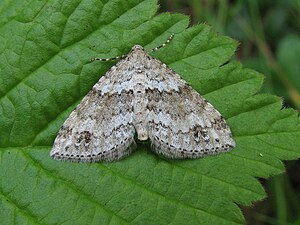Mountain forest herb tensioner
| Mountain forest herb tensioner | ||||||||||||
|---|---|---|---|---|---|---|---|---|---|---|---|---|

Mountain forest herb looser ( Mesotype didymata ), |
||||||||||||
| Systematics | ||||||||||||
|
||||||||||||
| Scientific name | ||||||||||||
| Mesotype didymata | ||||||||||||
| ( Linnaeus , 1758) |
The mountain forest herb wrench ( Mesotype didymata , syn .: Perizoma didymata ), sometimes also called anemone leaf wrench , is a butterfly from the family of the spanners (Geometridae). The species name is derived from the Greek word δίδυμος with the meaning "double" and refers to the blackish double spot on the upper side of the forewing of the butterfly.
features
butterfly
The moths reach a wingspan of 18 to 24 millimeters. There is no difference in color between the sexes. The wing color varies on the upper side from light gray to reddish brown. Typical of the species is a black double spot on the upper side of the forewing that touches the bright wavy line. This makes the moths unmistakable. The disk region is more or less darkened and bordered by lighter bands. A line made up of black dots extends along the edge and continues on the hind wings. The upper side of the hind wing has a gray-brown color and is provided with weak transverse lines and a dark band.
Caterpillar
Adult caterpillars are greenish in color and show yellow segment incisions, a dark back line as well as a whitish side stripe, a light abdominal surface and some dark gray, bristle-like hairs.
distribution and habitat
The distribution area of the mountain forest herb moth stretches from the Caucasus and the Urals through Russia to the far west of Europe, including the British Isles . The northernmost distribution extends to Lapland and the Faroe Islands . The main habitat are light deciduous and mixed forests, plains, heaths, raised bogs, herbaceous slopes and forest meadows. In the Alps , the species rises to heights of 2000 meters.
Way of life
The moths are crepuscular and nocturnal, sometimes they fly in the afternoon. They form a generation per year that can be found from June to September. At night they appear on artificial light sources . The caterpillars feed on the leaves of various plants, for example of bilberry ( Vaccinium myrtyllus ), bilberry ( Vaccinium uliginosum ) Fuchsschem Groundsel ( Senecio fuchsii ) or yellow gentian ( Gentiana lutea ). The caterpillars were also found on wood anemone ( Anemone nemorosa ). The species overwinters in the egg stage.
Individual evidence
- ^ Arnold Spuler : The butterflies of Europe , Volume 2, E. Schweizerbart'sche Verlagsbuchhandlung, Stuttgart, 1910, p. 46
- ↑ a b c Günter Ebert (Ed.): The butterflies of Baden-Württemberg. 1st edition. Volume 9. Moths VII. Geometridae 2nd part. 1 Ulmer, Stuttgart (Hohenheim), 2003, ISBN 3-8001-3279-6 , pp. 62-65
- ↑ a b Manfred Koch , Wolfgang Heinicke, Bernd Müller: We determine butterflies. Volume 4: Spanner. 2nd, improved and enlarged edition. Neumann, Leipzig / Radebeul 1976, DNB 780451570 , p. 126/127
- ↑ Walter Forster , Theodor A. Wohlfahrt : The butterflies of Central Europe. Volume 5: Spanner. (Geometridae). Franckh'sche Verlagshandlung, Stuttgart 1981, ISBN 3-440-04951-5 , p. 107
literature
- Günter Ebert (Ed.): The butterflies of Baden-Württemberg. 1st edition. Volume 8. Moth VI. Geometridae 1 Ulmer, Stuttgart 2001, ISBN 3-8001-3497-7
- Arno Bergmann: The large butterflies of Central Germany. Volume 5/1: Spanner. Distribution, forms and communities. Urania-Verlag, Jena 1955, DNB 450378403
Web links
- Lepiforum e. V. - Taxonomy and photos
- butterflies - nature butterflies
- ukmoths - Twin-spot Carpet at UKmoths
- britishlepidoptera - Information on the species
- kolumbus.fi - caterpillar
